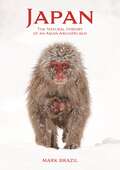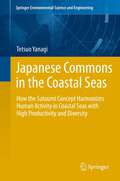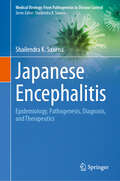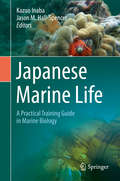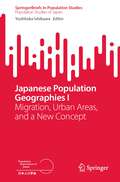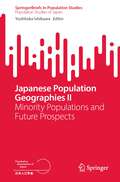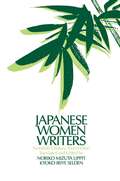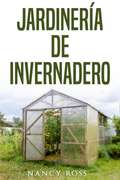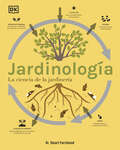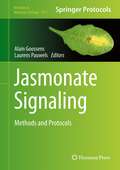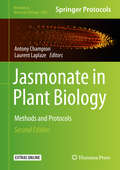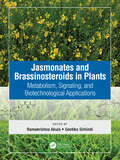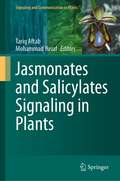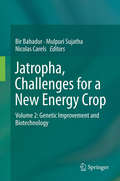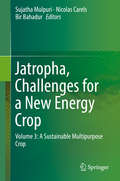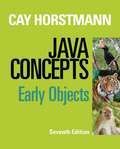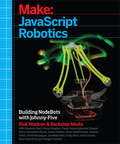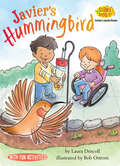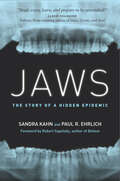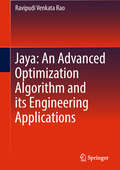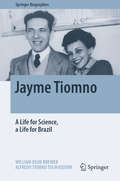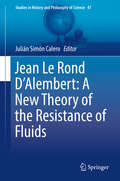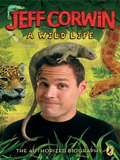- Table View
- List View
Japan: The Natural History of an Asian Archipelago (Wildlife Explorer Guides #18)
by Mark BrazilA comprehensive, richly illustrated guide to Japan’s astonishing animals and plants—and the natural forces that have shaped themThis richly illustrated guide is the first comprehensive and accessible introduction to the extraordinary natural history of the Japanese archipelago. It explains how Japan’s geology, geography, climate, seas and currents have forged conditions supporting a diverse range of species—from cranes, bears, eagles and monkeys to plants, butterflies, dragonflies, frogs and snakes—many of which are found nowhere else in the world. Engaging and authoritative, this book is a must-have for anyone who wants to explore or learn about Japan’s natural wonders, from the Japanese Macaque—the famous snow monkeys—to the magnificent Steller’s Eagle.Features more than 878 colour photographs, illustrations and mapsProvides a lavishly illustrated introduction to many of Japan’s common and iconic mammals and birdsTakes readers on a naturalist’s journey to the key areas of Hokkaido, Honshu, Kyushu, Shikoku and Nansei Shoto, as well as the Izu, Ogasawara and Iwo islandsIntroduces Japan’s geology, geography, topography, climate, habitats, biodiversity and much moreExplains where and how to watch and photograph wildlife in Japan, including whales
Japanese Commons in the Coastal Seas
by Tetsuo YanagiThe author proposed the satoumi concept, analogous to the satoyama concept on land, as "coastal sea with high biodiversity and productivity in harmony with human interaction" in 1998. The concept for environmental conservation in the coastal seas has been widely accepted and was included in the Japanese national policy of "Strategy for Establishment of an Environmental Nation" in 2007. This book is a translation of the author's Japanese book (2010) in response to concerns and questions about satoumi, including: Does biodiversity increase as a result of human interaction in coastal seas? Do the economics of fishing villages need to be considered in detail? What legal support is necessary for the creation of satoumi? Is there a relation between the concepts of God and Nature in satoumi? What is the relationship between fishermen and city dwellers? Chapter 1 presents the basic concept of satoumi. In Chapter 2 the relation between biodiversity and human interaction, economic problems related to satoumi, legal support for satoumi creation, satoumi from the point of view of landscape ecology, and the relation between society and science with regard to the satoumi movement are discussed. In Chapter 3 examples of satoumi creation in Japan are presented, and in Chapter 4 the overseas dissemination of the satoumi concept is introduced, with Chapter 5 providing the conclusion. Chapter 1 presents the basic concept of satoumi. In Chapter 2 the relation between biodiversity and human interaction, economic problems related to satoumi, legal support for satoumi creation, satoumi from the point of view of landscape ecology, and the relation between society and science with regard to the satoumi movement are discussed. In Chapter 3 examples of satoumi creation in Japan are presented, and in Chapter 4 the overseas dissemination of the satoumi concept is introduced, with Chapter 5 providing the conclusion.
Japanese Encephalitis: Epidemiology, Pathogenesis, Diagnosis, and Therapeutics (Medical Virology: From Pathogenesis to Disease Control)
by Shailendra K. SaxenaThis book provides a comprehensive overview of Japanese Encephalitis (JE), its pathobiology, and associated challenges for treatment and prevention. It focuses on various aspects of Japanese Encephalitis, including global epidemiology, genome organization and genotypes, virus-host interactions, immunopathogenesis, transmission dynamics, antibody-dependent enhancement, clinical characteristics, laboratory diagnosis, treatment, prevention, and control strategies. It provides a brief account of the Japanese encephalitis vaccine, their immunogenicity, protective ability, and impact of JE’s vaccine in reducing the burden of the disease. It also helps in understanding the molecular and cellular factors involved in the JE virus neuro-invasion and inflammatory processes. The book uniquely presents cutting-edge information and provides an edited information source for clinicians, virologists, pathologists, and immunologists.
Japanese Marine Life: A Practical Training Guide in Marine Biology
by Kazuo Inaba Jason M. Hall-SpencerThis book gives an overview of the diverse marine fauna and flora of Japan and includes practical guides for investigating the biology and ecology of marine organisms. Introducing marine training courses offered at a range of Japanese universities, this is the first English textbook intended for marine biology instructors and students in Japan. It provides essential information on experimental procedures for the major areas of marine biology, including cell and developmental biology, physiology, ecology and environmental sciences, and as such is a valuable resource for those in Asian countries that share a similar flora and fauna. It also appeals to visitors interested in attending Japanese marine courses from countries around the world.
Japanese Population Geographies I: Migration, Urban Areas, and a New Concept (SpringerBriefs in Population Studies)
by Yoshitaka IshikawaThis is the first anthology that conveys in detail the actual situation of population geographies in Japan, a country facing some of the world's most serious demographic trends such as low fertility, population aging, and depopulation. The anthology consists of two volumes with the common title Japanese Population Geographies. All of the included entries are based on original Japanese papers written by leading geographers and published within the past few years, useful for understanding Japan’s current population geographies. The first volume analyzes the postwar transition of internal migration, examining the structural changes of population in urban areas, and proposes a new measure different from the traditional resident population. This volume also presents an investigation of the retirement migration of baby boomers as well as displacement migration due to the 2011 Great East Japan Earthquake. The second volume’s contents examine the residential choices of minority populations such as foreign residents and sexual minorities. It also discusses future prospects associated with mono-polar concentration into Tokyo, regional forecasting using population projections based on small-area units, and the importance of a politico–economic perspective in the future research. Taken as a whole, this anthology offers the following two significant contributions. First, the excellent achievements obtained in Japan, which is experiencing serious demographic trends, reflect key developments within the context of the world's population geography. The second contribution is that the book brings the latest insights and important policy implications to countries that are facing various issues associated with decreasing fertility, aging population, and declining population.
Japanese Population Geographies II: Minority Populations and Future Prospects (SpringerBriefs in Population Studies)
by Yoshitaka IshikawaThis is the first anthology that conveys in detail the actual situation of population geographies in Japan, a country facing some of the world's most serious demographic trends such as low fertility, population aging, and depopulation. The anthology consists of two volumes with the common title Japanese Population Geographies. All of the included entries are based on original Japanese papers written by leading geographers and published within the past few years, useful for understanding Japan’s current population geographies. The first volume analyzes the postwar transition of internal migration, examining the structural changes of population in urban areas, and proposes a new measure different from the traditional resident population. This volume also presents an investigation of the retirement migration of baby boomers as well as displacement migration due to the 2011 Great East Japan Earthquake. The second volume’s contents examine the residential choices of minority populations such as foreign residents and sexual minorities. It also discusses future prospects associated with mono-polar concentration into Tokyo, regional forecasting using population projections based on small-area units, and the importance of a politico–economic perspective in future research. Taken as a whole, this anthology offers the following two significant contributions. First, the excellent achievements obtained in Japan, which is experiencing serious demographic trends, reflect key developments within the context of the world's population geography. The second contribution is that the publication brings the latest insights and important policy implications to countries that are facing various issues associated with decreasing fertility, aging population, and declining population.
Japanese Women Writers: Twentieth Century Short Fiction (Japan In The Modern World Ser.)
by Kyoko Iriye Selden Noriko Mizuta Lippit"Here are Japanese women in infinite and fascinating variety -- ardent lovers, lonely single women, political activists, betrayed wives, loyal wives, protective mothers, embittered mothers, devoted daughters. ... a new sense of the richness of Japanese women's experience, a new appreciation for feelings too long submerged". -- The New York Times Book Review
Jardinería de Invernadero
by Nancy RossLa jardinería de invernadero puede ser una gran forma para extender tu temporada de cosecha y, a la vez, divertirte más con este hobby. Para aquellos que viven en climas norteños, es normal tener que lidiar con ciertos problemas, heladas tardías o temperaturas bajas durante los principios de primavera. A menudo esto implica que las semillas no podrán germinar con facilidad. Con un invernadero adecuado, esto no será un obstáculo, debido a que te proveerá de condiciones aptas para que las plantas puedan florecer. Con esta guía, podrás comenzar un invernadero a tu gusto. Empezaremos explicando lo básico: proceso para plantar, cuánta agua necesitarás para cada planta, la temperatura correcta, cómo elegir la tierra (sustrato), eliminar plagas de forma natural. Cuando estés listo, incluso un principiante podrá comenzar su propio invernadero en poco tiempo. Cuando estés preparado para extender tus temporadas de cultivo y para sacarle el jugo a tu invernadero, mejor lee esta guía, aprenderás todo lo que necesitas para cultivar cualquier planta que quieras, sin importar donde vivas.
Jardinología (The Science of Gardening): La ciencia de la jardinería
by Dr. Stuart FarrimondUn libro de jardinería diferente que explica la ciencia detrás de la jardinería de forma visual y clara.¿El mundo de la botánica y la jardinería te parecen un misterio? Las guías de jardinería al uso tienden a dar gran cantidad de instrucciones y consejos, pero rara vez aportan explicaciones sobre el por qué. ¡No te preocupes! El Dr. Stuart Farromond arroja luz sobre todas esas preguntas que siempre te has hecho y te explica lo que sucede en tu jardín desde un enfoque científico.La guía botánica definitiva para entender los secretos de la horticultura y la floricultura como un profesional:Escrita con un lenguaje accesible y libre de tecnicismos en formato pregunta y respuesta. Con explicaciones claras, apoyadas por gráficos y esquemas para ilustrar los conceptos de forma visual.Estructurado en torno al ciclo de vida de un jardín, desde los primeros brotes hasta el momento de la poda.Explica los beneficios de la jardinería para la salud mental y el medio ambiente.Un práctico manual de jardinería con explicaciones y consejos avalados por la ciencia, que te ayudará a comprender mejor cómo se comportan las plantas, desmitificar creencias y descubrir las bases y avances de la horticultura moderna. ------------------------The only book to explain the science behind gardening practice in a simple and visually accessible way.The world of gardening can be a mystifying place, with so many instructions to follow and often little explanation as to why. Dr. Stuart Farromond casts his scientific eye over a typical year in the garden to answer all the horticultural questions you&’ve ever wanted the answer to. This great gardening book provides a shortcut to decades of gardening experience by explaining the science behind how a garden grows, featuring: An accessible guide structured around the life cycle of the garden, taking you from first shoots to pruning for renewal. An accessible Q &A format, with stats and infographics to bring the story to life, as well as long-held gardening myths are exploded by new science. Every way to greener fingers has an action point so that you can understand the science, apply your gardening practice, and enjoy a flourishing garden.From hands-on, practical advice, to an exploration of the mental health benefits of gardening, while also covering topics such as the positive impact gardening can have on the earth during a time of climate crisis in between, The Science of Gardening debunks myths and reveals the latest science only taught at horticultural college. As a passionate newcomer to gardening, daunted by the mountain of often conflicting advice in gardening manuals, Dr. Stu has set about testing the scientific basis of so much conventional wisdom and practice so you too can garden like a pro.
Jasmonate Signaling
by Alain Goossens Laurens PauwelsIt is now well established that jasmonates, originally identified as the major component of jasmine scent, play a universal role in the plant kingdom and are involved in the regulation of diverse aspects of plant biology, including growth, development, metabolism, and interaction with the environment. In Jasmonate Signaling: Methods and Protocols, experts in the field aim to unite powerful emerging omics platforms with a number of key reductionist approaches to form a comprehensive collection of tools and protocols. The detailed chapters in this book embrace physiological, environmental, molecular, omics, and bioinformatics approaches that allow dissecting jasmonate actions in the model species Arabidopsis thaliana or in other plants. Written in the highly successful Methods in Molecular Biology series format, chapters feature introductions to their respective topics, lists of the necessary materials and reagents, step-by-step, readily reproducible laboratory protocols, along with tips on troubleshooting and avoiding known pitfalls. Authoritative and cutting-edge, Jasmonate Signaling: Methods and Protocols will empower interested researchers to dissect all steps of jasmonate signaling and the processes they modulate.
Jasmonate in Plant Biology: Methods and Protocols (Methods in Molecular Biology #2085)
by Antony Champion Laurent LaplazeThis second edition volume expands on the previous edition with a look at the latest techniques used to study plant hormone jasmonate (JA). The chapters in this book and are organized into three parts: Parts One and Two discuss the role of JA in plant physiology and development, and in plant-biotic interactions. Part Three talks about methods used by researchers to study jasmonate metabolism and signaling. Written in the highly successful Methods in Molecular Biology series format, chapters include introductions to their respective topics, lists of the necessary materials and reagents, step-by-step, readily reproducible laboratory protocols, and tips on troubleshooting and avoiding known pitfalls.Cutting-edge and practical, Jasmonate in Plant Biology: Methods and Protocols, Second Edition is a valuable resource for both novice and expert researchers who are interested in learning more about this developing field.
Jasmonates and Brassinosteroids in Plants: Metabolism, Signaling, and Biotechnological Applications
by Ramakrishna Akula and Geetika SirhindiThis book provides a comprehensive update on recent developments of Jasmonates (JAs) and Brassinosteroids (BRs) in plant signalling and biotechnological applications. Over the last few decades, an enormous amount of research data has been generated on these two signalling molecules. This valuable compilation will enhance the basic understanding of JAs and BRs mechanism of actions ensuing tolerance mechanism of crops under climate changes for sustainable agriculture and human welfare. This book covers topics regarding the occurrence of JAs and BRs in plants, biosynthesis, role in plant growth and development, role of these PGRs during various abiotic stress tolerance in plants, crosstalk of Reactive Oxygen Species (ROS) and plant stress mitigation, regulation of JAs and BRs signaling pathways by microRNA, along with physiological and anatomical roles of JAs and BRs as wound healing, regeneration and cell fate decisions. The cross talk of JAs and BRs with neurotransmitters in plant growth and development. Bio-fortification of crop plants with BRs in managing in human health issues chapter enlightened new role of BRs in human wellbeing. This book will be beneficial to scientists, researchers, agriculturists, horticulturists, industries related to the crop and food production KEY FEATURES Reviews the global scientific literature and experimental data of the authors on the occurrence of JAs and BRs in various plants Update information on recent developments of JAs and BRs signalling and biotechnological applications in plants Highlights the physiological, metabolic and molecular mechanism of JAs and BRs under variable climates Addresses the abiotic and biotic tolerance management by JAs and BRs Describes the role of JAs and BRs in sustainable agriculture and human welfare in eco-friendly manner
Jasmonates and Salicylates Signaling in Plants (Signaling and Communication in Plants)
by Tariq Aftab Mohammad YusufDemand for agricultural crops and nutritional requirement continues to escalate in response to increasing population. Also, climate change exerts adverse effects on agriculture crop productivity. Plant researchers have, therefore, focused to identify the scientific approaches that minimize the negative impacts of climate change on agricultural crops. Thus, it is the need of the hour to expedite the process for improving stress tolerance mechanisms in agricultural crops against various environmental factors, in order to fulfil the world’s food demand. Among the various applied approaches, the application of phytohormones has gained significant attention in inducing stress tolerance mechanisms.Jasmonates are phytohormones with ubiquitous distribution among plants and generally considered to modulate many physiological events in higher plants such as defence responses, flowering and senescence. Also, jasmonates mediate plant responses to many biotic and abiotic stresses by triggering a transcriptional reprogramming that allows cells to cope with pathogens and stresses. Likewise, salicylates are important signal molecules for modulating plant responses to environmental stresses. Salicylic acid influences a range of diverse processes in plants, including seed germination, stomatal closure, ion uptake and transport, membrane permeability and photosynthetic and growth rate.Understanding the significant roles of these phytohormones in plant biology and from agriculture point of view, the current subject has recently attracted the attention of scientists from across the globe. Therefore, we bring forth a comprehensive book “Jasmonates and Salicylates Signalling in Plants” highlighting the various prospects involved in the current scenario. The book comprises chapters from diverse areas dealing with biotechnology, molecular biology, proteomics, genomics, metabolomics, etc. We are hopeful that this comprehensive book furnishes the requisite of all those who are working or have interest in this topic.
Jatropha, Challenges for a New Energy Crop, Volume 2: Genetic Improvement and Biotechnology
by Nicolas Carels Mulpuri Sujatha Bir BahadurJatropha curcas or Physic Nut is a small tree (bush plant) that produces fruits under tropical climate. The fruits contained seed that are ~40% oil rich. This oil is excellent for biodiesel. The bush is a now new coming crop because it may cope with harsh environmental conditions such as semi-aridity and poor land. It is considered as one alternative for climate mitigation that does not compete with arable land normally dedicated to food crop and can be used to regain degraded land or fight desertification. This bush has been considered seriously by the international community only recently (~2006-2008), but worldwide scientists did an outstanding job to drawn Jatropha out of its semi-wild status and bring it on the industrial scene. Problems remains, but we have now a comprehensive picture of this crop and almost every technological challenged were addressed. From now, the job will have to concentrate on breeding in order to domesticate this species. Therefore, it is the right time to sum up worldwide contributions in a comprehensive book with a breeding looking to improve the chance of this plant to stabilize as a crop and to fulfil with the expectations that humans invested in it. A book with this perspective will help international community to give a step on. The book will be a broad and comprehensive look on Jatropha until the details since the book is being contributed by international experts worldwide that have already published works in the international press of Science. Illustrations, tables geographic maps, GPS location, etc are added by each contributors according to the feeling they have concerning what they think their contribution should be.
Jatropha, Challenges for a New Energy Crop: Volume 3: A Sustainable Multipurpose Crop
by Nicolas Carels Bir Bahadur Sujatha MulpuriJatropha curcas, or physic nut, is a small tree that, in tropical climates, produces fruits with seeds containing ~38% oil. The physic nut has the potential to be highly productive and is amenable to subculture in vitro and to genetic modification. It also displays remarkable diversity and is relatively easy to cross hybridize within the genus. Thanks to these promising features, J. curcas is emerging as a promising oil crop and is gaining commercial interest among the biofuel research communities. However, as a crop, physic nut has been an economic flop since 2012, because the species was not fully domesticated and the average productivity was less than 2 t/ha, which is below the threshold of profitability.^7 t/ha could be reached and it is contributing to new markets in some countries. As such, it is important fro research to focus on the physiology and selective breeding of Jatropha . This book provides a positive global update on Jatropha, a crop that has suffered despite its promising agronomic and economic potential. The editors have used their collective expertise in agronomy, botany, selective breeding, biotechnology, genomics and bioinformatics to seek out high-quality contributions that address the bottleneck features in order to improve the economic trajectory of physic nut breeding.
Java Concepts: Early Objects
by Cay S. HorstmannIn Java Concepts, Cay Horstmann provides a comprehensive introduction to fundamental programming techniques and design skills helping the student master basic concepts. Realistic programming examples, homework assignments, and lab exercises build student problem-solving abilities.
JavaScript Robotics: Building NodeBots with Johnny-Five, Raspberry Pi, Arduino, and BeagleBone
by Lyza Danger Gardner Emily Rose Anna Gerber Sara Gorecki Backstop Media Bryan Hughes Pawel Szymczykowski Andrew Fisher Jonathan Beri Rick Waldron Kassandra Perch Donovan Buck David Resseguie Susan Hinton Raquel Velez Julian David DuqueJavaScript Robotics is on the rise. Rick Waldron, the lead author of this book and creator of the Johnny-Five platform, is at the forefront of this movement. Johnny-Five is an open source JavaScript Arduino programming framework for robotics. This book brings together fifteen innovative programmers, each creating a unique Johnny-Five robot step-by-step, and offering tips and tricks along the way. Experience with JavaScript is a prerequisite.
Javier's Hummingbird: Solids/liquids/gases (Science Solves It!)
by Laura DriscollSolve kid-sized dilemmas and mysteries with SCIENCE SOLVES IT! These fun science books for kids ages 5–8 blend clever stories with real-life science. Why did the dog turn green? Can you control a hiccup? Is that a UFO? Find the answers to these questions and more as kid characters dive into physical, life, and earth sciences. Javier has been waiting all winter for the hummingbirds to return. But one of them arrives early, while the weather is still cold. It's up to Javier to figure how to keep the nectar in the feeder from freezing solid! Books in this perfect STEM series will help kids think like scientists and get ahead in the classroom. Activities and experiments are included in every book!
Jaws: The Story of a Hidden Epidemic
by Paul R. Ehrlich Sandra KahnThere's a silent epidemic in western civilization, and it is right under our noses. Our jaws are getting smaller and our teeth crooked and crowded, creating not only aesthetic challenges but also difficulties with breathing. Modern orthodontics has persuaded us that braces and oral devices can correct these problems. While teeth can certainly be straightened, what about the underlying causes of this rapid shift in oral evolution and the health risks posed by obstructed airways? Sandra Kahn and Paul R. Ehrlich, a pioneering orthodontist and a world-renowned evolutionist, respectively, present the biological, dietary, and cultural changes that have driven us toward this major health challenge. They propose simple adjustments that can alleviate this developing crisis, as well as a major alternative to orthodontics that promises more significant long-term relief. Jaws will change your life. Every parent should read this book.
Jaya: An Advanced Engineering Optimization Algorithm And Its Applications
by Ravipudi Venkata RaoThis book introduces readers to the “Jaya” algorithm, an advanced optimization technique that can be applied to many physical and engineering systems. It describes the algorithm, discusses its differences with other advanced optimization techniques, and examines the applications of versions of the algorithm in mechanical, thermal, manufacturing, electrical, computer, civil and structural engineering.In real complex optimization problems, the number of parameters to be optimized can be very large and their influence on the goal function can be very complicated and nonlinear in character. Such problems cannot be solved using classical methods and advanced optimization methods need to be applied. The Jaya algorithm is an algorithm-specific parameter-less algorithm that builds on other advanced optimization techniques. The application of Jaya in several engineering disciplines is critically assessed and its success compared with other complex optimization techniques such as Genetic Algorithms (GA), Particle Swarm Optimization (PSO), Differential Evolution (DE), Artificial Bee Colony (ABC), and other recently developed algorithms.
Jayme Tiomno: A Life for Science, a Life for Brazil (Springer Biographies)
by William Dean Brewer Alfredo Tiomno TolmasquimJayme Tiomno (1920-2011) was one of the most influential Brazilian physicists of the 20th century, interacting with many of the renowned physicists of his time, including John Wheeler and Richard Feynman, Eugene Wigner, Chen Ning Yang, David Bohm, Murray Gell-Mann, Remo Ruffini, Abdus Salam, and many others.This biography tells the sometimes romantic, often discouraging but finally optimistic story of a dedicated scientist and educator from a developing country who made important contributions to particle physics, gravitation, cosmology and field theory, and to the advancement of science and of scientific education, in many institutions in Brazil and elsewhere. Drawing on unpublished documents from archives in Brazil and the US as well as private sources, the book traces Tiomno's long life, following his role in the establishment of various research facilities and his tribulations during the Brazilian military dictatorship. It presents a story of progress and setbacks in advancing science in Brazil and beyond, and of the persistence and dedication of a talented physicist who spent his life in search of scientific truth.
Jean Grave and the Networks of French Anarchism, 1854-1939 (Palgrave Studies in the History of Social Movements)
by Constance BantmanThis biography charts the life and fascinating long militant career of the French anarchist journalist, editor, theorist, writer, campaigner and educator Jean Grave (1854-1939), from the run up to the 1871 Paris Commune to the eve of the Second World War. Through Grave, it explores the history of the French and international anarchist communist movement over seven decades: its “heroic period” (1880-1890s), shaken by terrorist violence and intense repression, the emergence of syndicalism, national and international solidarity campaigns, the divisions over the First World War, and post-war division and relegation. Through Grave, a “sedentary transnationalist,” the study investigates the networked and transnational organisation of the anarchist movement, addressing the paradox of Grave’s international influence alongside his deep rootedness in Paris by emphasizing the movement’s global print culture and staggering circulations.
Jean Le Rond D'Alembert: A New Theory of the Resistance of Fluids
by Julián Simón CaleroIn the commentaries to this book we try to understand d’Alembert thoughts and how he contrives to translate his ideas on mechanics to the fluid realm with a new and radical point of view; how he arrives at the first two fundamental differential equations among the velocity components; and how he tries to reduce the resistance of a moving body, which is a change of its momentum, to the hydrostatical pressure, which is related to the gravity. All this knowing that his mechanics has no forces and no pressures as well, and that the fluids are aggregates of individual particles.The essay A New Theory of the Resistance of Fluids was a turning point in Fluid Mechanics because clearly, for the first time, the resistance is shown as the results of a fluid subjected to differential equations in a continuous mode instead of a set of impacts of individual particles. This contribution has been recognized by the scholars. However, only partial attention has been paid to this work, which can be justified due to the difficulty in its reading and also because it was eclipsed by the publication, a few years later, of Euler’s three Memoirs that established modern hydrodynamics.
Jean-Charles Houzeau's Escape from Texas: A Belgian Astronomer Caught in the American Civil War (Springer Biographies)
by Christiaan Sterken Amy Abercrombie KingTranslated from the original French and annotated with figures, historical maps and commentary from the translators, this work is Jean-Charles Houzeau's account of his escape from Texas during the American Civil War. Houzeau was a Belgian astronomer who worked a couple of years as assistant astronomer at the Brussels Observatory, but eventually moved to the United States. He was living as a frontierman in Texas when the Civil War broke out, and because he took an abolitionist stance and helped slaves escape, he was forced to flee to Mexico, from where he sailed to New Orleans on board of a US military vessel. Originally titled La terreur blanche au Texas et mon 'evasion, Houzeau captured the details of his escape in 1862.The editors, an astronomer and a French language teacher, have added supplementary material to give the readers more depth and historical context to the story.
Jeff Corwin: A Wild Life
by Jeff CorwinA fascinating look at the real Jeff Corwin! From growing up in an urban community near Boston, to falling in love with snakes, to traveling to exotic places, to becoming a beloved Emmy Award-winning television host of Animal Planet, this authorized biography will give readers a first-hand look at Jeff's amazing and adventurous life. Based on extensive research and one-on-one interviews with Jeff, kids will get an honest telling of Jeff Corwin's incredible journey from child nature enthusiast to naturalist and animal specialist. .
